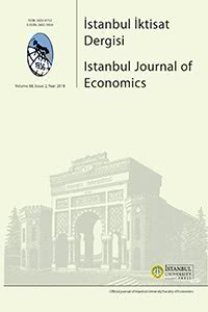Impact of Small and Medium-Sized Enterprises (SMEs) on the Sustainable Development in Yemen during the Period from 2000 to 2018: An Empirical Study
Impact of Small and Medium-Sized Enterprises (SMEs) on the Sustainable Development in Yemen during the Period from 2000 to 2018: An Empirical Study
___
- Angus, J. (1995). The united nations world summit for social development. Social Policy Journal of New Zealand, 3(4), 1–5.
- Barbier, E. B., & Markandya, A. (1990). The conditions for achieving environmentally sustainable development. European Economic Review, 34(2-3), 659-669.
- Braus, J., & Wood, D. (1993). Environmental education in the schools: Creating a program that works! (Vol. 2). Washington, USA: Peace Corps.
- Brians, C. L. (2016). Empirical political analysis: Pearson new international edition coursesmart etextbook. New York, USA: Routledge.
- Central Statistical Organization of Yemen http://cso-yemen.com/ Accessed 10 December 2020- 17 January 2021
- Çatal, M. F. (2007). Bölgesel kalkınmada küçük ve orta boy işletmelerin (kobi) rolü. Atatürk Üniversitesi Sosyal Bilimler Enstitüsü Dergisi, 10(2), 333–352.
- Dodds, F. (2014). Reforming the international institutions. In F. Dodds (Ed.). Earth Summit 2002 - A New Deal. London: Earthscan.
- Gennar, P. (2007). Key indicators of sustainable development. 2nd Kyoto International Seminar on Sustainable Growth in the Asia-Pacific Region, Kyoto, Japan.
- Gökçek, E., & Karakaya, Ö. (2020, Temmuz/July). Ekonomik kalkınmada işletmelerin rolü. Kongre Başkanı / Chair (Serkan DİLEK), Kastamonu Üniversitesi, 68-73.
- Hair Jr, J. F., Hult, G. T. M., Ringle, C. M., & Sarstedt, M. (2016). A primer on partial least squares structural equation modeling (PLS-SEM). Sage Publications.
- Hair Jr, J. F., Sarstedt, M., Ringle, C. M., & Gudergan, S. P. (2017). Advanced issues in partial least squares structural equation modeling. Sage Publications.
- Hallberg, K. (2000). A market-oriented strategy for small and medium scale enterprises (Vol. 63). World Bank Publications.
- Mebratu, D. (1998). Sustainability and sustainable development: Historical and conceptual review. Environmental Impact Assessment Review, 18(6), 493–520.
- Ministry of Industry & Trade Database- Yemen https://moit.gov.ye/moit/ Accessed 18 December 2020 – 22 January 2021) The Sustainable Development Goals h t t p s : / / w w w . u n . o r g / sustainabledevelopment/sustainable-development-goals/ Accessed 25 December 2020
- Mukwena, R. (2016). Zambia at fifty years: What went right, what went wrong and wither to? A treatise of the country’s socio-economic and political developments since independence. Partridge Africa. Retrieved from http://www.inderscience.com/storage/f681112109432175.pdf
- Muschett, F. D. (1996). Principles of sustainable development. CRC Press. Pezzey, J. (1992). Sustainability: An interdisciplinary guide. Environmental Values, 1(4), 321–362.
- Ringle, C., Da Silva, D., & Bido, D. (2015). Structural equation modeling with the SmartPLS. Brazilia Journal of Marketing, 13(2), 56-73.
- Safiriyu, A. M., & Njogo, B. O. (2012). Impact of small and medium scale enterprises in the generation of employment in Lagos State. Kuwait Chapter of the Arabian Journal of Business and Management Review, 1(11), 107-141.
- Sharafat, A. L. I., Rashid, H., & Khan, M. A. (2014). The role of small and medium enterprises and poverty in Pakistan: An empirical analysis. Theoretical and Applied Economics, 18(4), 64-80.
- Taiwo, M. A., Ayodeji, A. M., & Yusuf, B. A. (2012). Impact of small and medium enterprises on economic growth and development. American Journal of Business and Management, 1(1), 18–22.
- The OIC Statistics (OICStat) Database https://www.sesric.org/oicstat.php Accessed 25 December 2020 – 12 January 2021
- Wetzels, M., Odekerken-Schröder, G., & Van Oppen, C. (2009). Using PLS path modeling for assessing hierarchical construct models: Guidelines and empirical illustration. MIS Quarterly, 177–195.
- World Bank’s database https://data.worldbank.org/ Accessed 16 - 27 December 2020
- Zaidan, R. (2006). Activating the role of small and medium industrial industries in the process of economic and social development in Syria. Damascus University.
- ISSN: 2602-4152
- Yayın Aralığı: 2
- Başlangıç: 1939
- Yayıncı: İstanbul Üniversitesi
Çevre Kalitesi-Ekonomik Karmaşıklık İlişkisi: Türkiye Ekonomisi Üzerine Fourier Eşbütünleşme Analizi
Selma ÖNER, Hakan ÖNER, Hande KILIÇ SATICI
Türkiye‘de Sektörel Banka Kredilerinin Ekonomik Büyümeye Etkisi
Katılımcı Bütçeleme: Eleştirel Bir Yaklaşım
